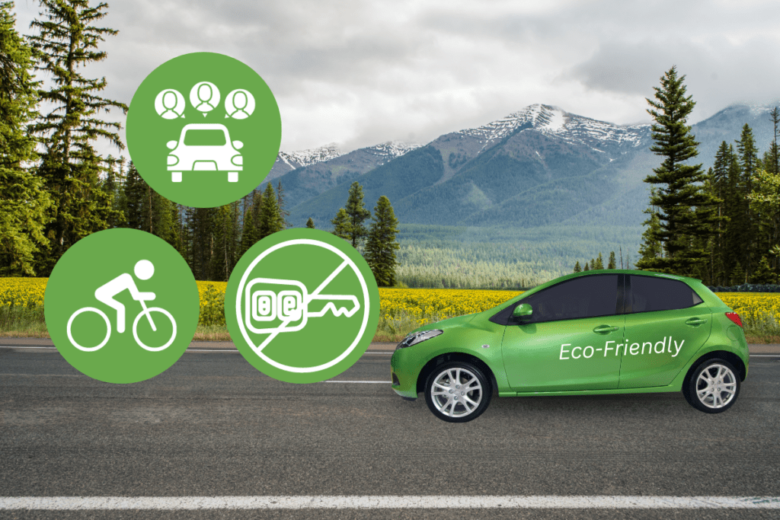Transportation is an integral part of modern life, connecting people to work, education, and leisure. However, the environmental impact of traditional modes of transportation, such as fossil fuel-powered vehicles, has reached critical levels. Carbon emissions from transportation constitute a significant chunk of global greenhouse gases, directly contributing to climate change, air pollution, and degradation of ecosystems. Sustainable transportation offers a solution, providing eco-friendly ways to minimize harm while ensuring mobility and convenience. Let’s explore a variety of sustainable transportation methods and how they can help create a greener future.
Walking and Biking
One of the simplest and most sustainable transportation methods is walking or biking. These modes of transport are not only zero-emission but also promote better health and well-being. Walking requires nothing more than a sturdy pair of shoes, and biking is increasingly accessible, with cities worldwide implementing bike-sharing programs and dedicated bike lanes. Short commutes, neighborhood errands, and leisure activities can easily shift to these options. Biking, in particular, is gaining traction as cities strive to reduce traffic congestion and improve air quality. Plus, it’s cost-effective and provides a sense of freedom and independence.
Public Transportation
Public transportation systems like buses, trains, and trams play a vital role in reducing the carbon footprint of urban mobility. A fully loaded bus or train has a significantly lower per-passenger emission rate compared to individual cars. By using public transport, individuals can help reduce congestion and energy use while benefiting from economical travel options. Many cities are now investing in cleaner transit systems, such as electric or hybrid buses, to further enhance sustainability. Expanding metro networks and adding high-speed rail lines are other significant steps that governments are taking to boost the efficiency of public transportation.
Electric Vehicles
Electric vehicles (EVs) are often regarded as the future of sustainable transportation. As they run on electricity rather than gasoline or diesel, EVs produce zero tailpipe emissions. With advancements in technology, EVs now offer extended ranges, faster charging capabilities, and improved affordability. The shift to EVs is further encouraged by the growing network of charging stations, making them increasingly practical for everyday use. When paired with renewable energy sources like solar or wind power, EVs offer an almost entirely green mobility solution. Transitioning to EVs is crucial for cutting down on greenhouse gas emissions, particularly in urban areas where vehicle density is high.
Carpooling and Ridesharing
Cars are here to stay, but how we use them can evolve. Carpooling and ridesharing services offer a middle ground between private vehicle ownership and public transportation. By sharing rides, whether with coworkers or through apps like Uber and Lyft, you can significantly reduce the number of vehicles on the road. Fewer cars mean less traffic congestion, reduced fuel consumption, and lower emissions. These services also tend to be more affordable since costs are shared among passengers. Many ridesharing companies are also exploring sustainable practices, such as deploying fleets of electric or hybrid vehicles, to make carpooling even greener.
Alternative Fuels
Transitioning from fossil fuels to alternative fuels is another pillar of sustainable transportation. Options like biofuels, hydrogen, and compressed natural gas (CNG) offer cleaner alternatives to gasoline and diesel. For example, biofuels derived from plants and organic waste reduce carbon emissions compared to conventional fuels. Hydrogen-powered vehicles produce water as their only emission, making them a promising technology for the future. While these fuels aren’t yet as widely available as traditional options, ongoing research and technological advancements are steadily improving their accessibility and affordability. The adoption of alternative fuels is a critical step toward reducing global dependence on non-renewable energy sources.
Urban Planning
Sustainable transportation doesn’t just rely on individual choices or technology; it’s also about designing urban spaces that encourage eco-friendly mobility. Cities around the world are rethinking their layouts to reduce car dependency and make walking, biking, and public transport more appealing. Mixed-use developments, where residential, commercial, and recreational spaces are closely integrated, can minimize the need for long commutes. Green corridors and pedestrian-friendly zones create livable, vibrant communities while reducing environmental impact. Urban planning that prioritizes sustainability benefits not just the environment but also improves quality of life for residents.
Government Initiatives
Governments play a vital role in fostering sustainable transportation by setting policies, funding green initiatives, and incentivizing eco-friendly practices. Subsidies for electric vehicles, tax breaks for using public transport, and grants for clean energy research are all examples of governmental support. Infrastructure development, such as building more bike lanes, expanding high-speed rail, and establishing charging stations for EVs, is also key. International agreements like the Paris Climate Accord further encourage nations to align their transportation goals with global sustainability targets. Government action ensures that sustainable transportation is not just a choice but an accessible option for all.
Personal Choices
While large-scale changes are essential, individual contributions also matter. Adopting sustainable transportation habits, like walking or biking for short distances, opting for public transport, or investing in an EV, can collectively make a significant impact. Being mindful about car usage and choosing to carpool or rideshare when possible reduces emissions and traffic congestion. Supporting businesses and initiatives that align with sustainable values further amplifies the effect. Budget constraints or limited options may make it challenging for some, but even small changes, when widely adopted, can help pave the way for a greener future.
A Greener, More Mobile Future
Sustainable transportation is not just a trend; it’s a necessary step toward reducing environmental impact and ensuring a healthier planet for future generations. By combining innovations like electric vehicles and alternative fuels with smarter urban planning and individual lifestyle changes, we can create a more balanced, eco-friendly mobility system. With governments, organizations, and individuals working together, a world with cleaner air, less congestion, and more equitable transportation is within reach. Start small, make informed choices, and be part of the change. Sustainable transportation is the road forward.
FAQs
1. What is the most sustainable mode of transportation?
Walking and cycling are considered the most sustainable options because they produce zero emissions and promote health.
2. Are electric vehicles truly eco-friendly?
Yes, especially when powered by renewable energy sources like solar or wind. They produce zero tailpipe emissions, significantly reducing pollution.
3. How does public transportation help the environment?
Public transit systems can carry many passengers at once, leading to fewer cars on the roads, lower traffic congestion, and reduced per-passenger emissions.
4. What role do governments play in sustainable transportation?
Governments can fund green initiatives, build sustainable transport infrastructure, and incentivize practices like EV adoption or carpooling.
5. How can I contribute to sustainable transportation?
Start by evaluating your daily transportation habits. Opt for walking, biking, or public transportation, and consider carpooling or investing in alternative fuel vehicles.




